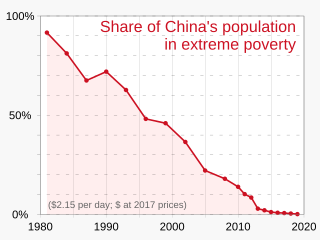
The economy of Vietnam is a developing mixed socialist-oriented market economy. It is the 35th-largest economy in the world by nominal gross domestic product (GDP) and the 26th-largest economy in the world by purchasing power parity (PPP). It is a lower-middle income country with a low cost of living. Vietnam is a member of the Asia-Pacific Economic Cooperation, the Association of Southeast Asian Nations and the World Trade Organization.

Transportation in Vietnam is improving rapidly in terms of both quantity and quality. Road traffic is growing rapidly but the major roads are dangerous and slow to travel on due to outdated design and an inappropriate traffic mix. In recent years, the construction of expressways has accelerated. Air travel is also important for long distance travel. Metro systems are under construction in the two metropolises of Hanoi and Ho Chi Minh City.

The dong has been the currency of Vietnam since 3 May 1978. It is issued by the State Bank of Vietnam. The dong was also the currency of the predecessor states of North Vietnam and South Vietnam, having replaced the previously used French Indochinese piastre.

Bắc Trung Bộ is one of the geographic regions of Vietnam. It consists of six provinces in northern part of Central Vietnam: Thanh Hóa, Nghệ An, Hà Tĩnh, Quảng Bình, Quảng Trị, Thừa Thiên–Huế. The last two provinces were the northernmost provinces of State of Vietnam and South Vietnam until Reunification of Vietnam in 1976. In the Nguyễn dynasty, this area was known as Hữu Trực Kỳ.

Poverty in India remains a major challenge despite overall reductions in the last several decades as its economy grows. According to an International Monetary Fund paper, extreme poverty, defined by the World Bank as living on US$1.9 or less in purchasing power parity (PPP) terms, in India was as low as 0.8% in 2019, and the country managed to keep it at that level in 2020 despite the unprecedented COVID-19 outbreak. According to the World Bank, India experienced a significant decline in the prevalence of extreme poverty from 22.5% in 2011 to 10.2% in 2019. A working paper of the bank said rural poverty declined from 26.3% in 2011 to 11.6% in 2019. The decline in urban areas was from 14.2% to 6.3% in the same period. The poverty level in rural and urban areas went down by 14.7 and 7.9 percentage points, respectively. According to United Nations Development Programme administrator Achim Steiner, India lifted 271 million people out of extreme poverty in a 10-year time period from 2005–2006 to 2015–2016. A 2020 study from the World Economic Forum found "Some 220 million Indians sustained on an expenditure level of less than Rs 32 / day—the poverty line for rural India—by the last headcount of the poor in India in 2013."
Poverty in Pakistan has been recorded by the World Bank at 39.3% using the lower middle-income poverty rate of US$3.2 per day for the fiscal year 2020–21. In September 2021, the government stated that 22% percent of its population lives below the national poverty line set at Rs. 3030 (US$10) per month.

Poverty is measured in different ways by different bodies, both governmental and nongovernmental. Measurements can be absolute, which references a single standard, or relative, which is dependent on context. Poverty is widely understood to be multidimensional, comprising social, natural and economic factors situated within wider socio-political processes.

The 1999 Vietnamese floods occurred in late October 1999 when Vietnam experienced the worst flooding in forty years. Tropical Storm No. 9 first appeared in heavy rain from 18 to 20 October, hitting the central provinces of Quang Binh, Quang Tri, Thua Thien Hue, Danang, Quang Nam in Vietnam. The rain was the first in a series of rainstorm events that lasted for two to three weeks.

In China today, poverty refers mainly to the rural poor. Decades of economic development has reduced urban extreme poverty. According to the World Bank, more than 850 million Chinese people have been lifted out of extreme poverty; China's poverty rate fell from 88 percent in 1981 to 0.7 percent in 2015, as measured by the percentage of people living on the equivalent of US$1.90 or less per day in 2011 purchasing price parity terms, which still stands in 2022.

Health in Vietnam encompasses general and specific concerns to the region, its history, and various socioeconomic status, such as dealing with malnutrition, effects of Agent Orange as well as psychological issues from the Vietnam War, tropical diseases, and other issues such as underdeveloped healthcare systems or inadequate ratio of healthcare or social workers to patients.
Bangladesh is an under-devoloped nation. Despite rapid economic growth, poverty remains a major issue. However, poverty has declined sharply in recent history. Shortly after its independence, approximately 90% of the population lived under the poverty line. However, since economic reforms and trade liberalization of early 1990s, along with accelerated economic growth since early-2000s, Bangladesh have experienced a dramatic progress in reducing poverty. The remarkable progress in poverty alleviation has been recognized by international institutions. According to World Bank, more than 33 million Bangladeshi people have been lifted out of poverty since 2000; as measured by the percentage of people living on the equivalent of US$1.90 or less per day in 2011 purchasing price parity terms.
The International Fund for Agricultural Development (IFAD) is an international financial institution and a specialized agency of the United Nations dedicated to eradicating rural poverty in Vietnam and other developing countries. IFAD supports more than 200 ongoing programmes and projects around the world.

In 2021, official government statistics reported that the Philippines had a poverty rate of 18.1%,, significantly lower than the 49.2 percent recorded in 1985 through years of government poverty reduction efforts. From 2018 to 2021, an estimated 2.3 million Filipinos fell into poverty amid the economic recession caused by the COVID-19 pandemic.

The 2021 Southeast Asian Games, officially known as the 31st Southeast Asian Games, 31st SEA Games or SEA Games 31, and also recognized as Viet Nam 2021, was the 31st edition of the Southeast Asian Games, the biennial regional multi-sport event which was held in Hanoi, Vietnam and its surrounding cities from 12 to 23 May 2022.
Pensions in Vietnam are provided through a state pension scheme called social insurance, and private life insurance-type schemes. The pension system of Vietnam was ranked 57th out of 70 economies according to a 2020 Allianz report. As of 2020, 11.4% of Vietnamese have reached retirement age, but this number is expected to triple by 2050.
Vietnam utilizes four main sources of renewable energy: hydroelectricity, wind power, solar power and biomass. At the end of 2018, hydropower was the largest source of renewable energy, contributing about 40% to the total national electricity capacity. In 2020, wind and solar had a combined share of 10% of the country's electrical generation, already meeting the government's 2030 goal, suggesting future displacement of growth of coal capacity. By the end of 2020, the total installed capacity of solar and wind power had reached over 17 GW. Over 25% of total power capacity is from variable renewable energy sources. The commercial biomass electricity generation is currently slow and limited to valorizing bagasse only, but the stream of forest products, agricultural and municipal waste is increasing. The government is studying a renewable portfolio standard that could promote this energy source.
Hunger in Bangladesh is one of the major issues that affects the citizens of Bangladesh. The nation state of Bangladesh is one of the most densely populated countries in the world and home for more than 160 million people. It progresses immensely in the Human Development Index, particularly in the areas of literacy and life expectancy, but economic inequality has increased and about 32% of the population, that is 50 million people, still live in extreme poverty.

The COVID-19 pandemic in Vietnam has resulted in 11,624,000 confirmed cases of COVID-19 and 43,206 deaths. The number of confirmed cases is the highest total in Southeast Asia, and the 13th highest in the world. Hanoi is the most affected locale with 1,649,654 confirmed cases and 1,238 deaths, followed by Ho Chi Minh City with 628,736 cases and 20,476 deaths; however, the Vietnamese Ministry of Health has estimated that the real number of cases may be four to five times higher.

The 2020 Central Vietnam floods were a series of floods in Central Vietnam, which also affected some areas in Cambodia and Laos in October and early November 2020. The floods focused heavily in several provinces including Thừa Thiên Huế, Hà Tĩnh, Quảng Bình, Quảng Trị, and Quảng Ngãi. The floods were mainly caused by the seasonal monsoon, though enhanced by numerous tropical cyclones.

The government of Vietnam prepared for the COVID-19 pandemic as early as the first cases in China emerged in December 2019, and pursued a zero-COVID strategy until September 2021.
















